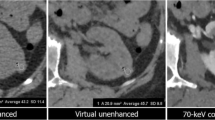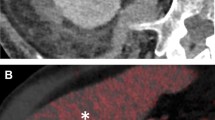Abstract
The aim of this study was to assess the ability of dual-energy computed tomography (DECT) to classify phantom renal lesions as cysts or enhancing masses. Six cylinders ranging in diameter from 0.5 to 3.0 cm were filled with distilled water or titrated iodinated contrast solutions with CT attenuation values at 120 kVp of 0 Hounsfield units (HU) for a cyst proxy or 10, 20, or 40 HU to represent enhancing masses. These were placed in a 12-cm-diameter renal phantom containing puréed beef mixed with iodinated contrast medium to simulate enhancing renal parenchyma of 100 and 250 HU and submerged within a 28-cm water bath. These combinations produced 48 individual phantom renal lesions of differing sizes, internal and parenchymal enhancement (12 cysts and 36 enhancing masses). DECT using 80 and 140 kVp was performed on a dual-source CT scanner. Commercial software created a color-encoded overlay indicating the location of iodine within the phantom. The lesions were individually graded as a cyst or enhancing mass by blinded, consensus interpretation of two genitourinary radiologists. Thirty-five of 36 enhancing masses and 10/12 cysts were correctly identified, equating to a sensitivity and specificity of 97% (95% CI 84–100%) and 83% (95% CI 51–97%), respectively. All lesions of 20- and 40-HU enhancement and 92% of 10-HU lesions were identified correctly. In a phantom model, the DECT iodine overlay technique is highly sensitive in detecting enhancing renal masses. Refinement of the technique remains necessary to improve specificity. If validated in patients, this may obviate the need for unenhanced acquisitions for renal mass characterization.




Similar content being viewed by others
References
Volpe A, Panzarella T, Rendon RA, Haider MA, Kondylis FI, Jewett MA (2004) The natural history of incidentally detected small renal masses. Cancer 1004:738–745
Suh M, Coakley FV, Qayyum A, Yeh BM, Breiman RS, Lu Y (2003) Distinction of renal cell carcinomas from high-attenuation renal cysts at portal venous phase contrast-enhanced CT. Radiology 2282:330–334
Siegel CL, Fisher AJ, Bennett HF (1999) Interobserver variability in determining enhancement of renal masses on helical CT. AJR Am J Roentgenol 1725:1207–1212
Israel GM, Bosniak MA (2005) How I do it: evaluating renal masses. Radiology 2362:441–450
Macari M, Bosniak MA (1999) Delayed CT to evaluate renal masses incidentally discovered at contrast-enhanced CT: demonstration of vascularity with deenhancement. Radiology 2133:674–680
Millner MR, McDavid WD, Waggener RG, Dennis MJ, Payne WH, Sank VJ (1979) Extraction of information from CT scans at different energies. Med Phys 61:70–71
Johnson TR, Krauss B, Sedlmair M, Grasruck M, Bruder H, Morhard D, Fink C, Weckbach S, Lenhard M, Schmidt B, Flohr T, Reiser MF, Becker CR (2007) Material differentiation by dual energy CT: initial experience. Eur Radiol 176:1510–1517
McCollough CH, Bruesewitz MR, Kofler JM (2006) CT dose reduction and dose management tools: overview of available options. Radiographics 262:503–512
Kopka L, Fischer U, Zoeller G, Schmidt C, Ringert RH, Grabbe E (1997) Dual-phase helical CT of the kidney: value of the corticomedullary and nephrographic phase for evaluation of renal lesions and preoperative staging of renal cell carcinoma. AJR Am J Roentgenol 1696:1573–1578
Graser A, Johnson TR, Chandarana H, Macari M (2008) Dual energy CT: preliminary observations and potential clinical applications in the abdomen. Eur Radiol. doi: 10.1007/s00330-008-1122-7
Duchene DA, Lotan Y, Cadeddu JA, Sagalowsky AI, Koeneman KS (2003) Histopathology of surgically managed renal tumors: analysis of a contemporary series. Urology 625:827–830
Jinzaki M, Tanimoto A, Mukai M, Ikeda E, Kobayashi S, Yuasa Y, Narimatsu Y, Murai M (2000) Double-phase helical CT of small renal parenchymal neoplasms: correlation with pathologic findings and tumor angiogenesis. J Comput Assist Tomogr 246:835–842
Birnbaum BA, Maki DD, Chakraborty DP, Jacobs JE, Babb JS (2002) Renal cyst pseudoenhancement: evaluation with an anthropomorphic body CT phantom. Radiology 2251:83–90
Chung EP, Herts BR, Linnell G, Novick AC, Obuchowski N, Coll DM, Baker ME (2004) Analysis of changes in attenuation of proven renal cysts on different scanning phases of triphasic MDCT. AJR Am J Roentgenol 1822:405–410
Coulam CH, Sheafor DH, Leder RA, Paulson EK, DeLong DM, Nelson RC (2000) Evaluation of pseudoenhancement of renal cysts during contrast-enhanced CT. AJR Am J Roentgenol 1742:493–498
Heneghan JP, Spielmann AL, Sheafor DH, Kliewer MA, DeLong DM, Nelson RC (2002) Pseudoenhancement of simple renal cysts: a comparison of single and multidetector helical CT. J Comput Assist Tomogr 261:90–94
Takahashi N, Hartman RP, Vrtiska TJ, Kawashima A, Primak AN, Dzyubak OP, Mandrekar JN, Fletcher JG, McCollough CH (2008) Dual-energy CT iodine-subtraction virtual unenhanced technique to detect urinary stones in an iodine-filled collecting system: a phantom study. AJR Am J Roentgenol 1905:1169–1173
Scheffel H, Stolzmann P, Frauenfelder T, Schertler T, Desbiolles L, Leschka S, Marincek B, Alkadhi H (2007) Dual-energy contrast-enhanced computed tomography for the detection of urinary stone disease. Invest Radiol 42:823–829
Author information
Authors and Affiliations
Corresponding author
Rights and permissions
About this article
Cite this article
Brown, C.L., Hartman, R.P., Dzyubak, O.P. et al. Dual-energy CT iodine overlay technique for characterization of renal masses as cyst or solid: a phantom feasibility study. Eur Radiol 19, 1289–1295 (2009). https://doi.org/10.1007/s00330-008-1273-6
Received:
Revised:
Accepted:
Published:
Issue Date:
DOI: https://doi.org/10.1007/s00330-008-1273-6




